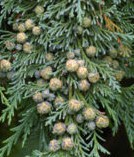 Of all the Christmas greens you can buy, Cedar can cause the most confusion. Several different greens are sold as cedar and none of them are true cedars. True cedars are in the genus Cedrus and none of them are native to North American. The Christmas greens sold as cedar share some characteristics but also have significant differences.
Of all the Christmas greens you can buy, Cedar can cause the most confusion. Several different greens are sold as cedar and none of them are true cedars. True cedars are in the genus Cedrus and none of them are native to North American. The Christmas greens sold as cedar share some characteristics but also have significant differences.
There are three cedars that are most in demand at Christmas: Port Orford-cedar (Chamaecyparis lawsoniana), Western Red Cedar (Thuga plicata), and Incense Cedar (Calocedrus decurrens). All of them are indigenous western North America and were important to the native American population there.
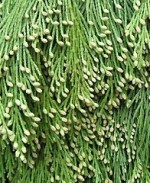
 Incense Cedar (Calocedrus decurrens) is probably the most unusual and showy in a Christmas arrangement. The bright green leaves contrast well with the many blue-green and dark green foliage of other Christmas greens and the small yellow male cones make the branches look as though they have been adorned with beads of gold. The wood was highly valued by the native Americans and they used it to build everything from houses to fences, bows, and baskets. The leaves were used in cooking and for medicines to cure stomach problems and colds; the boughs and twigs were used for brooms, and the administration of sweatbaths while the bark was used for baskets and temporary houses. Even the roots were valued for their use as twine.
Incense Cedar (Calocedrus decurrens) is probably the most unusual and showy in a Christmas arrangement. The bright green leaves contrast well with the many blue-green and dark green foliage of other Christmas greens and the small yellow male cones make the branches look as though they have been adorned with beads of gold. The wood was highly valued by the native Americans and they used it to build everything from houses to fences, bows, and baskets. The leaves were used in cooking and for medicines to cure stomach problems and colds; the boughs and twigs were used for brooms, and the administration of sweatbaths while the bark was used for baskets and temporary houses. Even the roots were valued for their use as twine.
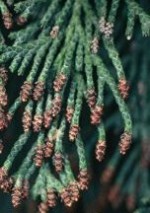
 Port Orford Cedar (Chamaecyparis lawsoniana), also known as Lawson’s cypress, has feathery blue-green foliage that is borne in flat sprays. Small cones are borne on he boughs and create a rustic look when present. The native Americans used the wood to build their sweat lodges, semi-subterranean houses and various personal items. Unfortunately, terrible root disease has threatened the trees since 1923.
Port Orford Cedar (Chamaecyparis lawsoniana), also known as Lawson’s cypress, has feathery blue-green foliage that is borne in flat sprays. Small cones are borne on he boughs and create a rustic look when present. The native Americans used the wood to build their sweat lodges, semi-subterranean houses and various personal items. Unfortunately, terrible root disease has threatened the trees since 1923.
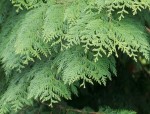
 Wester Red Cedar (Thuja plicata), also known as Arbrovitae, meaning tree of life, is a very long lived tree and has flat foliage that is green on top with a whitish caste to the lower side. Archaeological evidence indicates that various parts of the tree have been used for about 8,000 years. The traditional cutting of the tree involved a ritual that is still observed by some of the native American’s and others who still use the wood to carve totem poles. In past times the trees were also used for building canoes.
Wester Red Cedar (Thuja plicata), also known as Arbrovitae, meaning tree of life, is a very long lived tree and has flat foliage that is green on top with a whitish caste to the lower side. Archaeological evidence indicates that various parts of the tree have been used for about 8,000 years. The traditional cutting of the tree involved a ritual that is still observed by some of the native American’s and others who still use the wood to carve totem poles. In past times the trees were also used for building canoes.
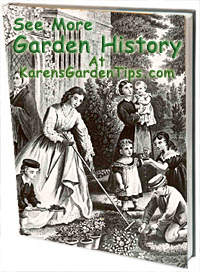 All three of these greens provide an interesting texture to Christmas arrangements and all lie somewhat flat. Two may provide additional interest too; Port Orford Cedar adds brown cones, Incense Cedar bright yellow ones. Florists carry these greens at Christmas but big box stores do not so check local online sources, remembering that these greens come from the west coast.
All three of these greens provide an interesting texture to Christmas arrangements and all lie somewhat flat. Two may provide additional interest too; Port Orford Cedar adds brown cones, Incense Cedar bright yellow ones. Florists carry these greens at Christmas but big box stores do not so check local online sources, remembering that these greens come from the west coast.